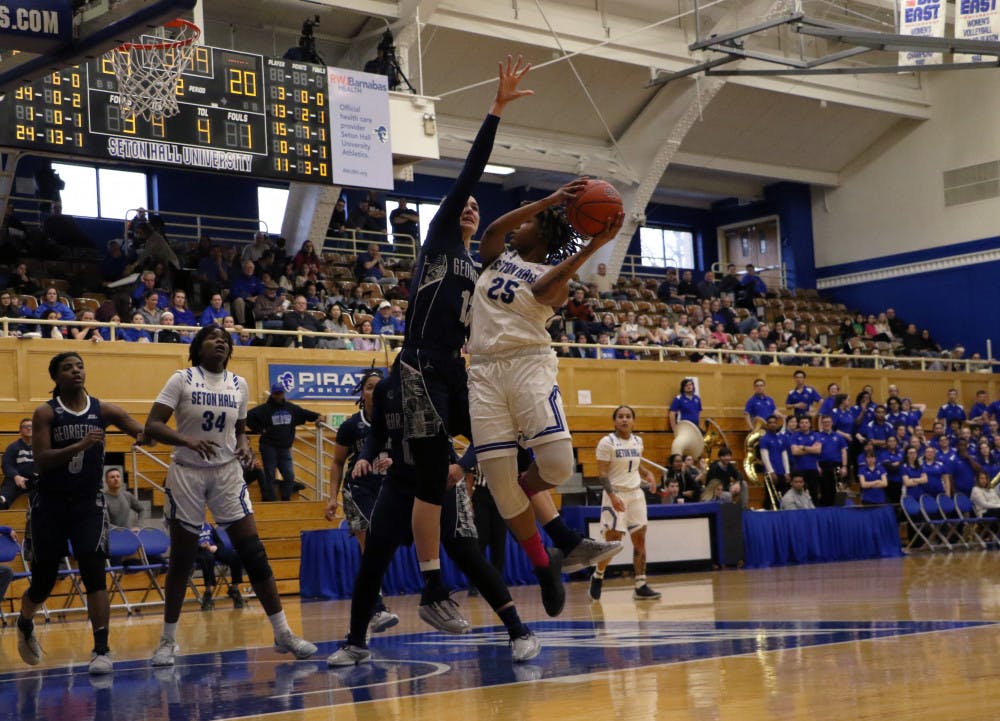[caption id="" align="alignnone" width="250"] shu.edu[/caption]
Seton Hall serves as a leader in promoting gender equality in the STEM field with women constituting about 55 percent of the 919 total undergraduate STEM students enrolled in 2015. The data provided in an email from Connie Beale, director of the Office of Institutional Research, showed that 501 of the 919 students are women.
Beale’s data also revealed that out of the 131 bachelor STEM degrees awarded in 2014 to 2015, 67 of them were awarded to women, which is 51 percent—higher than the national average which stands at 36 percent.
Seton Hall awards Clare Boothe Luce Program scholarships and summer fellowships to outstanding females majoring in STEM fields every year. Laura Schoppmann, an associate professor and program adviser for mathematics education, said in an email that there are 11 students in the current academic year that have received the scholarship which covers students’ tuitions.
Marian Glenn, professor in the department of biological sciences, said in an email that although there are fewer women in these fields, “STEM is an exciting area to be involved in, in terms of new discoveries, and the rapid expansion of technical innovation.”
The National Science Foundation (NSF) has a program called ADVANCE to, “increase the representation and advancement of women in academic science and engineering careers, thereby contributing to the development of a more diverse science and engineering workforce,” its website said.
Since there is an underrepresentation of women in STEM fields nationally, ADVANCE supports “advancing the status of women in academic science and engineering.”
Leanne Mocniak, a senior biochemistry major and Clare Boothe Luce scholar, said in an email interview that the sciences have a higher population of men than women, but she does not feel that she is at a disadvantage.
Mocniak said that her biology classes tend to have more female students while her physics classes have more male students, but each class fluctuates in the difference of ratio in women to men.
Sarah Pranaitis, sophomore majoring in biology on the pre-med track, said in an email that SHU has provided her with an encouraging environment and opportunities in the STEM field. She said that all of the women doctors and scientists that she has been in contact with are encouraging and supportive of her career goals and ambitions.
Pranaitis added that she plans on going to medical school after she graduates from Seton Hall. She said that she is looking forward to interacting with others in the field, working as a team with colleagues, and providing care to patients.
Samantha Todd can be reached at samantha.todd@student.shu.edu
shu.edu[/caption]
Seton Hall serves as a leader in promoting gender equality in the STEM field with women constituting about 55 percent of the 919 total undergraduate STEM students enrolled in 2015. The data provided in an email from Connie Beale, director of the Office of Institutional Research, showed that 501 of the 919 students are women.
Beale’s data also revealed that out of the 131 bachelor STEM degrees awarded in 2014 to 2015, 67 of them were awarded to women, which is 51 percent—higher than the national average which stands at 36 percent.
Seton Hall awards Clare Boothe Luce Program scholarships and summer fellowships to outstanding females majoring in STEM fields every year. Laura Schoppmann, an associate professor and program adviser for mathematics education, said in an email that there are 11 students in the current academic year that have received the scholarship which covers students’ tuitions.
Marian Glenn, professor in the department of biological sciences, said in an email that although there are fewer women in these fields, “STEM is an exciting area to be involved in, in terms of new discoveries, and the rapid expansion of technical innovation.”
The National Science Foundation (NSF) has a program called ADVANCE to, “increase the representation and advancement of women in academic science and engineering careers, thereby contributing to the development of a more diverse science and engineering workforce,” its website said.
Since there is an underrepresentation of women in STEM fields nationally, ADVANCE supports “advancing the status of women in academic science and engineering.”
Leanne Mocniak, a senior biochemistry major and Clare Boothe Luce scholar, said in an email interview that the sciences have a higher population of men than women, but she does not feel that she is at a disadvantage.
Mocniak said that her biology classes tend to have more female students while her physics classes have more male students, but each class fluctuates in the difference of ratio in women to men.
Sarah Pranaitis, sophomore majoring in biology on the pre-med track, said in an email that SHU has provided her with an encouraging environment and opportunities in the STEM field. She said that all of the women doctors and scientists that she has been in contact with are encouraging and supportive of her career goals and ambitions.
Pranaitis added that she plans on going to medical school after she graduates from Seton Hall. She said that she is looking forward to interacting with others in the field, working as a team with colleagues, and providing care to patients.
Samantha Todd can be reached at samantha.todd@student.shu.edu





